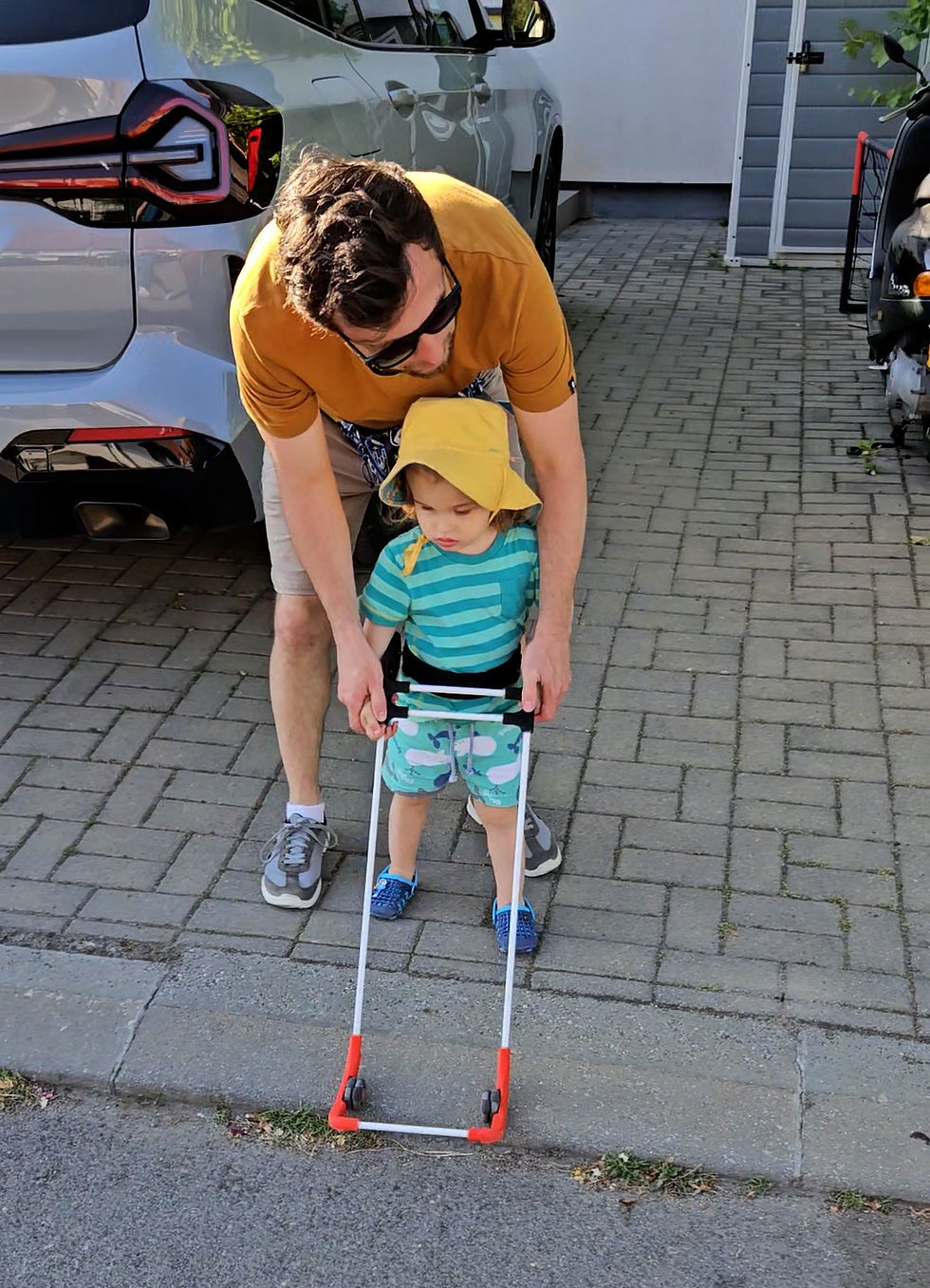Persistent “cruising” and “wide-based gait” are signs of mobility visual impairment and blindness
- Grace Ambrose-Zaken

- Oct 23, 2019
- 4 min read
Updated: Sep 16, 2020
It is commonly accepted that achievement of gross motor milestones varies across children. For example, the pictured milestone charts indicate “cruising”, the term used to describe when a baby steps sideways while holding on to a stable piece of furniture, can be expected by twelve months of age; yet some children may already be walking on or before their first birthdays.
However, given this trajectory, the motor milestone chart suggests that children observed cruising at twelve months will likely exhibit walking with “wide-based” gaits by fifteen months. Three months later, the wide-based gait should resolve into an ability to “walk avoiding obstacles”. By two years, typically developing children are expected to demonstrate the ability to “run avoiding obstacles”. Thus milestone charts indicate that typically developing children who begin walking earlier or later will exhibit similar intervals of gross motor milestone achievement; as they continuously improve in their visual-motor coordination.

Children who were born severely visually impaired or blind often do exhibit the ability to walk on time, but stop or return to cruising and walking only with assistance. Fraiberg (1977) described this phenomenon as “start-stop” pattern of motor development, where motor development milestones such as reaching, creeping, and walking began emerging and then stopped.
These outcomes beg the question, whether the term “cruising” continues to be applicable for a two-year-old child who is blind and who has no way to safely transition to the next milestone of “walks avoiding obstacles”. When children who are born severely visually impaired or blind have no neuromuscular disabilities, then it is their inability to visually avoid obstacles that makes it impossible for them to achieve that eighteen-month motor milestone “walks avoiding obstacles”.
Therefore, it would seem inappropriate (and unfair) to use the terminology “delayed gross motor skills” as this language suggests that these milestones are attainable given sufficient practice and encouragement to walk. It is more accurate to say, children who are blind cannot see and are therefore unable to achieve the visual motor coordination needed to attain the gross motor milestone “walks avoiding obstacles”.

Thus, eighteen-month-old children who are blind and mobility visually impaired are not able to visually avoid obstacles while walking, simply because they cannot see the obstacles. It has nothing to do with their physical body and everything to do with their sensory impairment.
Further, three-year-old children who are severely visually impaired or blind who have "a wide-based gait” when crossing open space are not the same as 15-month-old sighted children. The three-year-old who is blind is unable to narrow gait support without sufficient path information, whereas 15-month old sighted children have sufficient path information and they are able to narrow their gait support strategies with walking practice.
Sighted fifteen-month-old children lack experience, yet through trial and error they improve their gaits through refining their visual-motor coordination. Three-year-old children with severe visual impairment and blindness exhibit gait anomalies uniquely related to their visual impairment.
It is their visual impairment that causes their poor gait patterns and they have no way to improve their visual motor coordination. Therefore, it is through no fault of their own that they are in a motor milestone holding pattern. This inability to avoid obstacles can only be ameliorated through an appropriate mobility tool that provides consistent tactile path information.
In other words, four-year-old children who are blind and therefore cannot “run (visually) avoiding obstacles” are not two years behind their sighted peers, they are visually impaired. They can and do run when provided with tactile path information through the pediatric belt cane.
Their ability to catch up can occur when given a replacement for their faulty vision, a mobility tool that supplies them with the information they need about the path ahead. However, without accessible path information they cannot avoid obstacles while running simply because they cannot see the obstacles.
Therefore, instead of labeling these children as having delayed gross motor skills, these observable indicators can help families and early intervention professionals identify these children as mobility visually impaired or blind (MVI/B). By identifying them correctly, families and professionals are able to appropriately recommend their children as needing consistent tactile path information.
Consistent tactile path information can enable children who are born MVI/B to achieve the next phase of motor milestones, by providing them with independent information about obstacles before contacting them suddenly with their bodies. Mobility tools that provide them with consistent tactile path information allow them sufficient reaction distance and time needed to learn how to best interact with obstacles they encounter.
Once children who are MVI/B are provided with consistent tactile path information they are able to resume proper gross motor milestone attainment. Pediatric belt canes (aka Toddler Canes) are an effective means of providing children aged five and younger with consistent tactile path information. When children who are MVI/B aged five and younger wear their canes most of the day, every day they are able to obtain the information they need about the path ahead in order to avoid harmful bodily collisions.








Comments